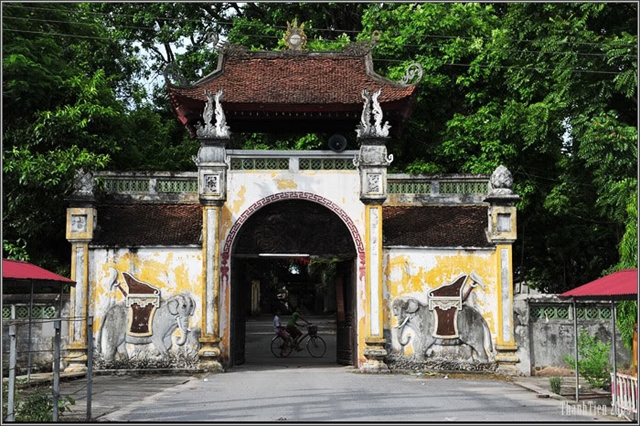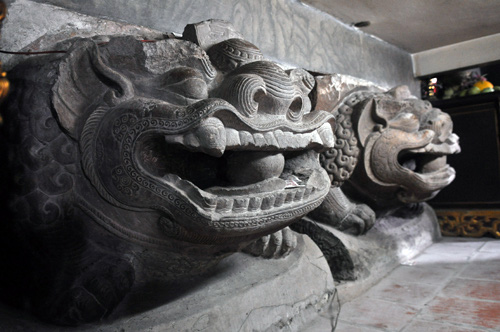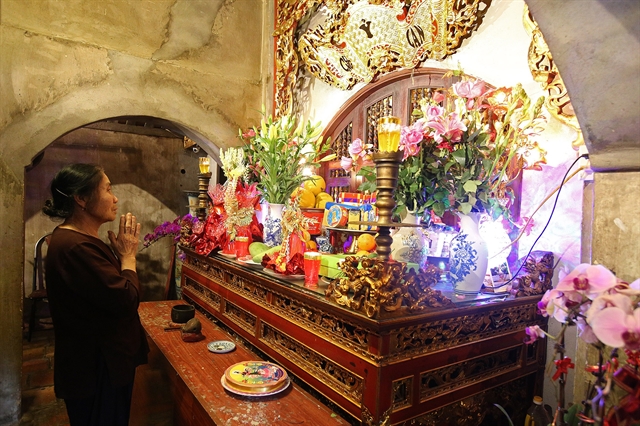 Features
Features

The two new national treasures – a pair of stone lion statues and a red-lacquered altar trimmed with gold – are expected to help turn the thousand-year-old pagoda into a top tourism destination in the capital.

|
| HISTORIC: Bà Tấm Pagoda, located on the outskirts of Hà Nội, preserves many precious ancient artefacts, including two new national treasures.Photo hanoimoi.com.vn |
By Phương Hà
Among 27 national treasures that have recently been recognised by Prime Minister Nguyễn Xuân Phúc, two are in Bà Tấm Pagoda located in Dương Xá Commune, Gia Lâm District on the outskirts of Hà Nội.
The two new national treasures – a pair of stone kylin statues and a red-lacquered altar trimmed with gold – are expected to help turn the thousand-year-old pagoda into a top tourism destination in the capital.
Legend has it that Bà Tấm Pagoda was built during the Lý Dynasty (1009-1225) to pay tribute to both the Buddha and Ỷ Lan, also known as Empress Mother Linh Nhân.
According to historical documents, Ỷ Lan, originally a descendant of the Lê family, was born in 1044 in Thổ Lỗi Village, which was later changed to Siêu Loại Village in Thiên Đức District. During the Nguyễn Dynasty (1802-1945), this area was located within Thuận Thành District in the northern province of Bắc Ninh and by 1961, it was integrated into Hà Nội, becoming present-day Dương Xá Commune.
Ỷ Lan was born into a family of silkworm mulberry growers and was famous for her intelligence, beauty and gentle attitude.
She was the concubine of King Lý Thánh Tông (ruling from 1054–1072) and the mother of King Lý Nhân Tông (reign 1072-1128). The empress took the position of regent twice and was accredited with ruling the country, helping the Lý Dynasty flourish.
A follower of Buddism, the empress ordered the construction of many temples throughout the country. She received much respect from citizens and was regarded as Bà Tấm (Lady Tấm) or Buddha Guan Yin – the embodiment of tolerance, virtue and goodness.
After she passed away in 1117, she was worshipped at the pagoda in her hometown, which is called Bà Tấm Pagoda. Over the years, the building has suffered a lot of severe damage.
In 2018, local officials utilised the district’s budget and villagers’ contributions to conduct a general repair and embellishment of the pagoda, aiming to restore and preserve its traditional values.
The striking feature of the pagoda is its collection of precious artefacts, particularly the two recently recognised national treasures – a pair of stone kylin statues dating back to the 12th century and the red-lacquered altar trimmed with gold dating from the 16th century.
The two artefacts meet three important criteria to be recognised as national treasures, including unique originality, unique forms and special values in terms of culture, history, art, particularly those associated with figures with meritorious services to the people and the nation. In this case, Empress Mother Linh Nhân.
The pair of stone kylin statues serve as a support of a Buddha altar. The kylins are 1.2m high and 1.36m wide, carved from monolithic rock. The word Vương, meaning King, on the foreheads of the kylins shows they were made following an order from a royal member. The kylins’ manes, ears and mouths are decorated with the symbol of lightning and halo, manifesting the teachings of Buddhism. Featuring all the skills of Vietnamese artisans, the statues are considered masterpieces of 12th-century Vietnamese art.
Likewise, the red-lacquered altar trimmed with gold shows the talents of Vietnamese artisans in the 16th century. The altar, carved with designs of flowers, leaves and sacred animals, has high architectural and sculptural values. It is in a chamber dedicated to worshipping the empress, which is set up like the forbidden palace where she used to live. Next to the empress statuette are statuettes of six female servants, emphasising her noble status.
The pagoda also possesses many other ancient artefacts that date back to the Lý Dynasty including stones, pottery pieces, stone crocodile statues, and a well.
Notably, there are four ancient stone steles that date back to the later Lê Dynasty (1428 to 1789) and Nguyễn Dynasty (1802-1945), including stele Đức Long inscription in the 6th year (1635) and the King Bảo Đại inscription in 1943, recording the years of renovations of the pagoda.
Archaeological excavations conducted by Hà Nội’s Department of Culture, Sports and Tourism and Việt Nam National Museum of History in 2003, 2013 and 2015 confirmed the significant cultural and historical values of Bà Tấm Pagoda.
“The excavations confirmed the existence of a large-scale architectural structure of the Lý Dynasty that was constructed by the empress in 1115,” says Nguyễn Ngọc Chất, head of the Department of Research and Collecting from Việt Nam National Museum of History.
“The relics and artefacts excavated also confirmed the position and influence of the empress as well as her Buddhist ideology in the spiritual life and traditional consciousness of the Vietnamese,” he asserts.
Spiritual tourism destination
For years, locals have visited Bà Tấm Pagoda to seek relaxation and tranquillity.
On every first day of each lunar month or on full moon days, they come to the pagoda to burn incense and pay tribute to the Buddha and the empress.
The festival of Bà Tấm Pagoda is held from the 19th to the 21st day of the second lunar month, attracting not only people from Gia Lâm District but from nearby provinces of Bắc Ninh and Hưng Yên and around the country.
“After the official ceremony conducted by the local elders, the villagers and visitors start to give offerings,” says Nguyễn Minh Huy, an elder of Dương Xá Commune.
“According to tradition, after the ceremony, the offerings will then be divided into two halves, one of which is given to the village where Empress Ỷ Lan was born and the rest is given to other villages in the commune.
“During the festival, apart from the procession, traditional games and singing performances have always attracted a large number of participants,” he adds.
With the advantage of being located by Highway 5 and preserving a collection of highly valued cultural and historical artefacts, Bà Tấm Pagoda has the potential to become a spiritual tourism destination.
According to Phùng Thị Hoài Hương, head of the Culture and Information Department of Gia Lâm District, the pagoda, together with other local relics like Phù Đổng Temple, Phú Thị Pagoda, Keo Pagoda, Chử Xá Communal House and festivals that have been recognised as the national intangible cultural heritage like Gióng Temple Festival, has enriched spiritual and cultural tourism in the district.
In addition, the district has many craft villages with great tourism potential as well, such as Bát Tràng and Kim Lan pottery villages.
“The collaboration with travel agencies in Hà Nội to develop specific tours and routes has been conducted by Gia Lâm District culture and tourism authorities in recent years.
“In the future, we plan to offer new tourism products, including connecting the relics of Bà Tấm Pagoda with other relics and craft villages in the district and surrounding areas to improve services for tourists. In addition, the district will focus on promoting the values of new national treasures to preserve and popularise them in Vietnamese spiritual and cultural life,” Hương says. VNS

|
| ROAR: The pair of stone lion statues at Bà Tấm pagoda in Hà Nội.Photo nld.com.vn |

|




